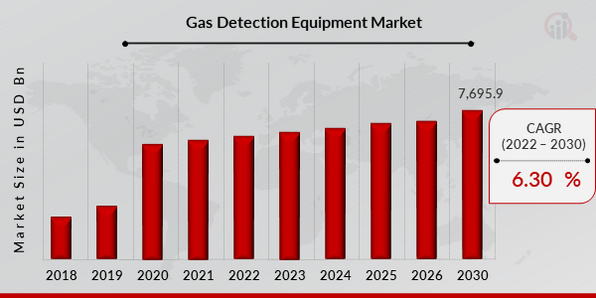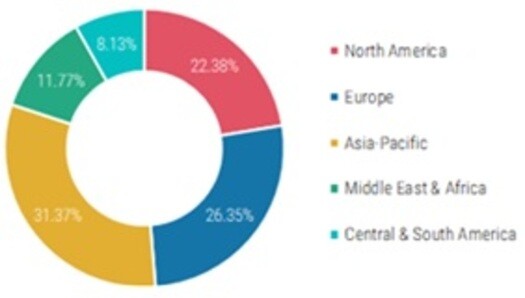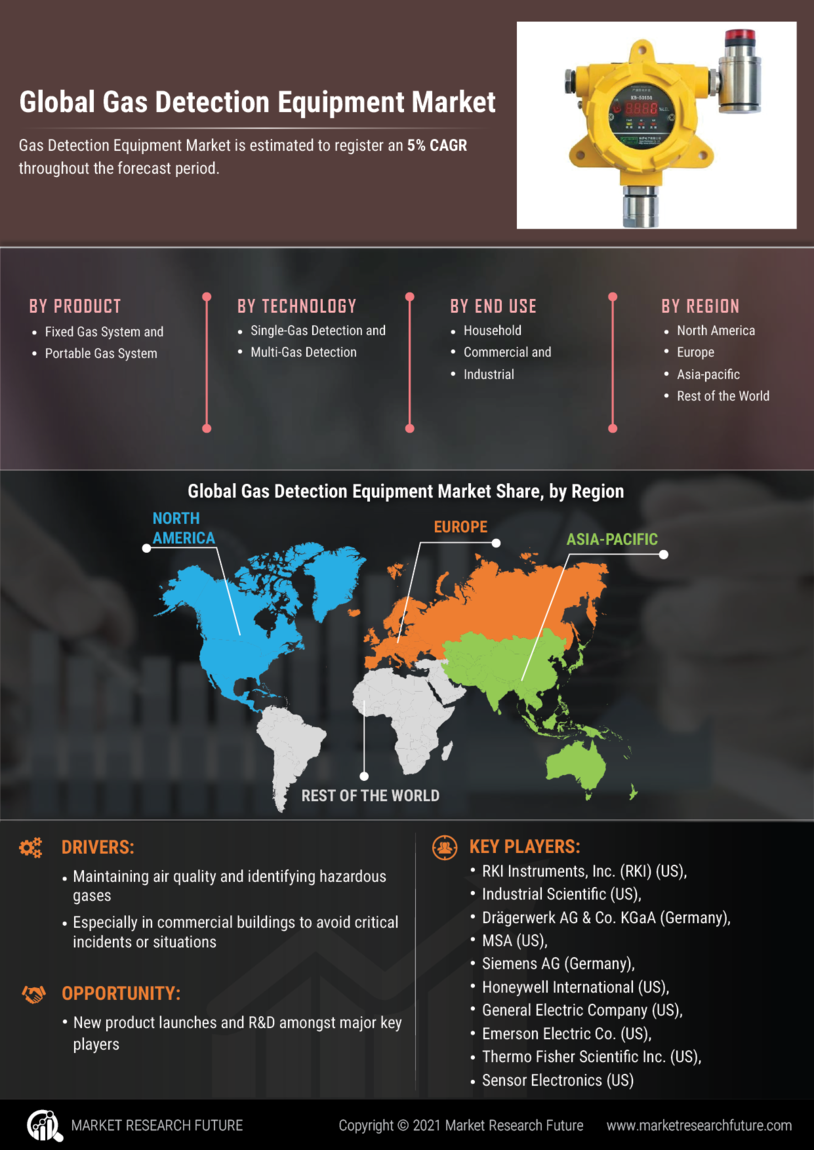The Global Gas Detection Equipment Market is projected to register a CAGR of 6.30% and reach a value of USD 7,695.9 million by 2030.
Gas Detection Equipment Market Overview
Gas detection equipment help reduce the risks related to hazardous gases in the household, commercial, and industrial sectors. The gas detection equipment can be used as a part of a total, integrated monitoring, and safety system, which includes various safety aspects including fire detection and emergency process shutdown. Increasing implementation of stringent safety regulations across the globe is anticipated to act as one of the significant factors for the rising growth of global gas detection equipment market during the forecast period. On the other hand, growth of the end use industries has been witnessing a substantial growth over the last few years which in turn accelerates the demand of gas detection equipment market during the forecast period.
Recent Developments:
July 2023 – MSA Safety Incorporated, in the first week of July, disclosed that it had been offered a USD 7 million contract to supply firefighters from five Fire Authorities in the United Kingdom with MSA's M1 Self-Contained Breathing Apparatus (SCBA) and connected firefighter technology. The Fire Authorities contain West Midlands Fire and Rescue Authority; Warwickshire Fire Service; Staffordshire Fire & Rescue Service; Hereford and Worcester Fire Service; and Cleveland Fire Brigade. The contract was properly granted late last month, and equipment deliveries will likely start later this year. The latest announcement builds on the company's success in the region, a year after the London Fire Brigade announced their MSA respiratory protective equipment selection. The judgment to improve the Fire Services' breathing apparatus technology was made after a massive and thorough evaluation, which concentrated on using enhanced technology to expand firefighter safety.June 2023- PHMSA's 52 purported regulatory corrections would reduce methane releases from new and existing gas pipelines. The US Pipeline and Hazardous Materials Safety Administration (PHMSA) is presenting supervisory alterations relating to 49 Code of Federal Regulations (CFR) Parts 191, 192, and 193 related to Pipeline Safety: Gas Pipeline Leak Detection and Repair that would lower methane releases from new and existing gas transmission pipelines, regulated facilities, and distribution pipelines. Written comments on this NPRM must be entered by August 16, 2023. PHMSA offers a tentative date for this rulemaking of six months after publishing a final rule in the Final Register.July 2023- Honeywell International stated in the first week of July stated that it has been granted to buy an Israel-based provider of operational technology and Internet-of-Things cybersecurity solutions for monitoring large-scale networks, SCADAfence in a trade that augments the conglomerate's cybersecurity portfolio. The terms of the deal are yet to be disclosed.
COVID-19 Impact Analysis
The COVID-19 pandemic has adversely affected the gas detection equipment business and will continue to pose risks. There are numerous risks related to the outbreak of the COVID-19 pandemic. COVID-19 spread glbally in 2020 and continues to impact economic activity around the globe. COVID-19 caused disruption and volatility in the global capital markets and resulted in an economic slowdown during 2020. The pandemic and its associated economic uncertainty negatively impacted the gas detection equipment market in most regions and across various customers. For instance, Siemens’ portfolio of companies comprises businesses that include a broad range of customized and application-specific products, software, solutions, systems, and services for different industries, including oil & gas, mining, cement, water, marine, wind, fiber, logistics, and energy, shows a delayed response to changes in the overall economic environment due to outbreak of COVID-19 pandemic. In regards to COVID-19, governments around the world have introduced certain measures, such as travel prohibitions, shutdowns of certain businesses, bans on group events and gatherings, shelter-in-place orders, curfews, and recommendations of practicing social distancing. These restrictions have resulted in weakening activity and temporary closures of manufacturing facilities.
Gas Detection Equipment Market Dynamics
Gas detection equipment can monitor and measure a single or a mixture of gas concentrations. Gas detection equipment can be wireless (portable) or fixed. Wearable or portable gas detection equipment is usually worn on the person and triggers an alarm once it detects the gas concentration above the limit threshold. Various sensors such as ultrasonic, infrared, and electrochemical gas are integrated into it. They find applications in household activities, automobiles, refineries, and industrial facilities, among others. With the increasing emphasis on ensuring the safety of workers in various end-use industries around the world, the adoption of various protective systems such as gas detectors has been promoted. Various industry standards were put in place, along with government rules and regulations to ensure the safety and health of workers in the manufacturing industry, necessitating the requirement for gas detectors. However, the growth of the market can be hindered due to the high cost of gas detection equipment.
Drivers:
-
The implementation of stringent safety regulatins
Government agencies worldwide make efforts to mitigate oil and methane gas emissions, in turn stimulating the growth of gas detection equipment. To monitor efficiency and safety in a range of applications, infrared gas detection sensors are widely used to detect methane leakage. It is of utmost importance to keep occupational exposure of personnel to toxic gases to acceptable levels based on industry guidelines. This forces industries to install gas detection equipment. Another important factor is the growing awareness among owners and industry workers that professional gas detection equipment plays a vital role in reducing the damage caused by methane leaks during transport, extraction of natural gas, and power generation. Further, mitigating methane emissions is considered one of the cost-effective methods for cutting global emissions. For instance, in January 2020, the Canadian government committed to reducing oil & gas methane emissions by 40%–45% below 2012 levels by 2025, thereby directly propelling the gas detection equipment market demand during the review period.
Restraint:
-
The high cost of gas detection equipment
Gas detectors measure or monitor levels of toxic gases, oxygen, and combustible gases in an area as part of a safety system. These detectors normally sound an alarm and are used in confined spaces or areas where exposure to such a gas could result in a toxic exposure or fire hazard. Gas detectors are available as portable and fixed units. Gas detectors are made up of various types of gas sensors such as thermal conductivity gas sensors, MEMS pellistors, catalytic pellistors, infrared gas sensors, metal oxide gas sensors, indoor air quality sensors, and electrochemical gas sensors, the use of the mentioned sensors depend upon the application areas of gas detectors. To achieve high reproducibility and repeatability, the fabrication process to develop gas sensors becomes costly. For instance, installing multi-walled carbon nanotubes (MWCNTs) into the conducting layer of the sensor is a highly intensive labor job. Thus, increasing the cost of gas detection equipment due to their advantages such as high reproducibility, low response time, high sensitivity, and long-term stability.
Opportunities:
-
Scope for growth in developing nations
Emerging economies like India, China, and Indonesia continuously invest in infrastructure development projects such as water treatment plants, oil & gas industries, various mining projects. Asia-Pacific is the most attractive market due to the high cash flows generated from the use of corporate infrastructure and equipment. The rise of industrial clusters, as well as the growth of FDI in all major manufacturing sectors in emerging economies such as China, India, Brazil, and Southeast Asian countries, are expected to dominate the market for gas detection equipment during the forecast period. Emerging economies focus on various foreign promoters who intend to start their business through FDI incentive programs. This will indirectly increase economic growth and strengthen industrialization. For instance, in 2020, the FDI inflow is estimated to be around USD 859 billion in the first half of the year. In addition, these countries have evolved and restructured their manufacturing policies and procedures to attract investment and enable growth. Industrialization is expected to increase the automation process to facilitate operations and improve production efficiency. Vietnam is one of the leading economies in Asia with a substantial growth rate and rapid development. The government has started investing in this sector to ensure stable growth and development in the infrastructure and manufacturing sector. This will lead to the huge development of advanced product development programs across the country. Hence, the growing scope in developing countries is an opportunity in the global gas detection equipment market.
Gas Detection Equipment Market Segment Overview
By Type
Based on type, the global gas detection equipment market has been segmented into fixed gas and portable gas systems. The fixed gas system segment accounted for the largest market share of 70.20% in 2020 while the portable gas system segment is expected to exhibit the highest CAGR of 6.66% during the review period
By Technology
Based on Technology, the global gas detection equipment market has been segmented into single-gas detection and multi-gas detection. The multi-gas detection segment accounted for the larger market share of 57.63% in 2020 whereas the single-gas detection segment is projected to register highest CAGR of 6.36% during the forecast period.
By End Use
Based on end use, the global gas detection equipment market has been segmented into household, commercial, and industrial. The industrial segment accounted for the largest market share of 71.80% in 2020 whereas the commercial segment is expected to register the highest CAGR of 6.63%
Global Gas Detection Equipment Market Share, by Region, 2020 (%) Sources: MRFR Analysis
Sources: MRFR Analysis
Gas Detection Equipment Market Regional Analysis
By region, the Global Gas Detection Equipment Market has been divided into North America, Europe, Asia-Pacific, Middle East & Africa and Central & South America. Asia-Pacific accounted for the largest market share of 31.37% in 2020. Europe was the second-largest market in 2020 and is projected to exhibit a CAGR of 5.57% during the review period. Whereas Central & South America is expected to register the highest CAGR of 7.56% during the forecast period.
Asia-Pacific
The gas detection equipment market in Asia-Pacific accounted for 22.38% of the global market in 2020. Asia-Pacific accounts for the largest share in the global gas detection equipment market owing to the high number of chemical manufacturing plants, mature petroleum sector, significant manufacturing industry, robust demand from the industrial sector, and high penetration of major players in the region. China accounts for a major stake in the region, accounting for 49.46% of the market, and is expected to register a CAGR of 6.17% during the forecast period. The market is growing gradually in this region due to the improving economic conditions in developing nations. Moreover, robust growth in the infrastructure and increasing investments in safety & security in China, India, and Japan is expected to increase the demand for gas detection equipment in the coming years. Moreover, the region is home to major manufacturing industries across electronics, consumer products, specialty chemicals, and others. Hence, the region is expected to exhibit a CAGR of 6.49% and retain its leading position during the forecast period.
Europe
The demand in the region has shown gradual growth owing to the increasing investments in production of chemicals and active ingredients. The increase in demand for electronics and retail products and the growing automotive industry are expected to augment the growth of the gas detection equipment market in the region. Germany accounts for more than 25.13% of the regional market and is expected to exhibit the CAGR of 5.64% during the forecast period. The UK is the second-largest market in the region, accounting for 21.24% in 2020, and is expected to register a CAGR of 5.66% during the forecast period. France's gas detection equipment market is expected to register a CAGR of 5.85% during the forecast period and is expected to be valued at USD 367.6 million by 2030.
Gas Detection Equipment Market Competitive Landscape
The market comprises tier-1, tier-2, and local players. The tier-1 and tier-2 players have a global reach and diverse product portfolios. Companies such Siemens AG (Germany), General Electric Company (Liechtenstein), Emerson Electric Co. (US), MSA Safety Inc. (US) and Honeywell International Inc. (US) dominate the global market due to brand reputation, product differentiation, financial stability, and diversified regional presence.
Prominent players in the Global Gas Detection Equipment Market include Siemens AG (Germany), Honeywell International Inc. (US), General Electric Company (Liechtenstein), Thermo Fisher Scientific Inc. (US), Emerson Electric Co. (US), Industrial Scientific (US), Sensor Electronics Corporation (US), CONSPEC Controls (Pennsylvania), Drägerwerk AG & Co. KGaA (Germany), RKI Instruments, Inc. (US), and MSA Safety Inc. (US).
Recent Developments
Few developments that occurred in recent times influencing the market growth of gardening tools are listed below:
- In June 2021, General Electric research developed Compact Vapor Chemical Agent Detector (CVCAD), a wearable detector to give first responders early warning of dangerous chemicals in the air.
- In October 2020, Emerson has acquired Progea Group, an industry-leading provider of industrial internet of things (IIoT), plant analytics, human-machine interface (HMI), and supervisory control and data acquisition (SCADA) technologies. This acquisition has helped bridge a critical customer technology gap by lowering the total cost of ownership and reducing the barriers to working across multiple vendors to drive more successful digital transformation and integration.
Gas Detection Market Scope of the Report
Global Gas Detection Equipment Market, by Product Type
- Fixed Gas System
- Portable Gas System
Global Gas Detection Equipment Market, By Technology
- Single-Gas Detection
- Multi-Gas Detection
Global Gas Detection Equipment Market, by End Use
Global Gas Detection Equipment Market, by Region
-
North America
-
Europe
- Germany
- France
- UK
- Italy
- Rest of Europe
-
Asia-Pacific
- China
- India
- Japan
- Rest of Asia-Pacific
-
Middle East & Africa
- Central & South America
- Brazil
- Argentina
- Rest of Central & South America
Intended Audience
- Mining Industries
- Wastewater Treatment Plants
- Oil and Gas Refineries
- Industrial plants
- Pharmaceutical manufacturers
- Chemical Industries
- Retailers
| Report Attribute/Metric |
Details |
| Market Size |
USD 7,695.9 million |
| CAGR |
6.30% CAGR (2024-2030) |
| Base Year |
2023 |
| Forecast Period |
2024-2030 |
| Historical Data |
2019 & 2023 |
| Forecast Units |
Value (USD Million) |
| Report Coverage |
Revenue Forecast, Competitive Landscape, Growth Factors, and Trends |
| Segments Covered |
Product, Technology and End-Use |
| Geographies Covered |
North America, Europe, Asia-Pacific, and Rest of the World (RoW) |
| Key Vendors |
RKI Instruments, Inc. (RKI) (US), Industrial Scientific (US), Drägerwerk AG & Co. KGaA (Germany), MSA (US), Siemens AG (Germany), Honeywell International (US), General Electric Company (US), Emerson Electric Co. (US), Thermo Fisher Scientific Inc. (US), and Sensor Electronics (US) |
| Key Market Opportunities |
New product launches and R&D amongst major key players |
| Key Market Drivers |
Maintaining air quality and identifying hazardous gases Especially in commercial buildings to avoid critical incidents or situations |
Gas Detection Equipment Market Highlights:
Frequently Asked Questions (FAQ) :
The global gas detection equipment market is expected to record a USD 7,695.9 million substantial market valuation.
The global gas detection equipment market is projected to register a moderate 6.30% CAGR in the forecast period.
The Gas Detection Equipment Market is segmented into end-use, Technology and Product.
The technology segment is divided into Single-Gas Detection and Multi-Gas Detection.
Some of the important key players are Honeywell International in the US, Siemens AG in Germany, Thermo Fisher Scientific Inc. in the US, Emerson Electric Co. In the US.






 Sources: MRFR Analysis
Sources: MRFR Analysis



















